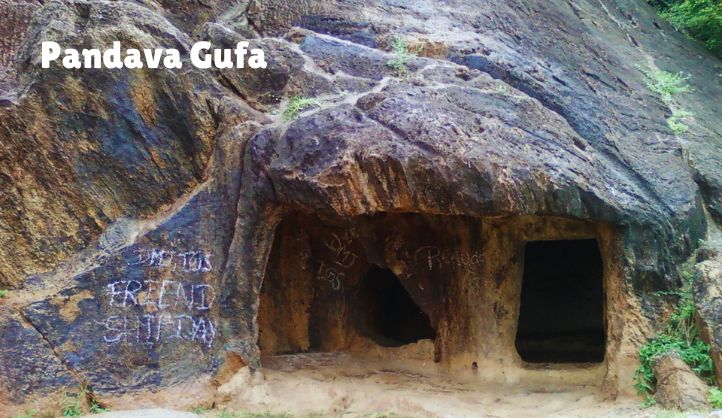Nestled in the heart of the Himalayas, Gangotri is not just a pilgrimage site but also a place where the natural beauty of the mountains and the spiritual essence of Indian mythology blend seamlessly. Among the various sites of religious and historical significance in this sacred town, Pandava Gufa stands out as a symbol of ancient mysticism and spiritual resonance. This hidden gem, located approximately 1.5 km from Gangotri Temple, is believed to have been the resting place of the Pandavas, the legendary heroes of the Mahabharata, during their journey to the Himalayas.
This article takes you on an in-depth journey to explore Pandava Gufa, its historical and mythological significance, the spiritual experiences it offers, and the awe-inspiring beauty of its surroundings. We will alsoo discuss how to reach this mystical cave, what to expect during your visit, and the best time to explore this ancient site.
Mythological Significance of Pandava Gufa
The Pandava Gufa holds a special place in Indian mythology, particularly in the epic Mahabharata. According to legend, after the great Kurukshetra war, the Pandavas embarked on a journey to seek the blessings of Lord Shiva and attain salvation. This journey, known as the Mahaprasthanika Parva, took them to the Himalayas, where they undertook severe penance to atone for the sins committed during the war.
Pandava Gufa is believed to be one of the resting places of the Pandavas during this arduous journey. It is said that they meditated and sought spiritual guidance in this cave, finding solace and peace in its tranquil surroundings. The cave is particularly associated with Bhima, the second of the Pandava brothers, who is believed to have spent considerable time here in deep meditation.
The spiritual aura of the Pandava Gufa is palpable, with devotees and visitors often recounting a sense of peace and divine connection upon entering the cave. The presence of the Pandavas, revered for their righteousness and valor, adds a layer of sanctity to the site, making it a significant spot for those on a spiritual quest.
The Geographical Setting and Natural Beauty
Pandava Gufa is set against the backdrop of the majestic Himalayan range, offering breathtaking views of snow-capped peaks, lush green valleys, and the serene Bhagirathi River flowing nearby. The trek to the cave is an experience in itself, with a well-marked trail that takes you through dense deodar and pine forests. The soothing sounds of nature, combined with the crisp mountain air, create a perfect setting for meditation and introspection.
The cave itself is nestled amidst large boulders, and its entrance is relatively small, requiring visitors to bend slightly to enter. Once inside, the cave opens up into a spacious chamber with a naturally formed altar where devotees often light lamps and offer prayers. The cool, dark interior of the cave contrasts with the bright, sunny exterior, enhancing the sense of mysticism and ancient reverence.
The surroundings of Pandava Gufa are equally captivating, with numerous spots for meditation and reflection. The serene ambiance, away from the hustle and bustle of modern life, allows visitors to connect deeply with nature and their inner selves. The entire area exudes a sense of timelessness, as if the very stones and trees have witnessed the passage of centuries and the presence of great sages and warriors.
How to reach
- By Air: The nearest airport to Gangotri is Jolly Grant Airport in Dehradun, which is about 250 km away. The airport is well-connected with major cities in India, such as Delhi, Mumbai, and Bengaluru. From the airport, you can hire a taxi or take a bus to Gangotri.
- By Train: The nearest railway station is Rishikesh Railway Station, which is approximately 234 km from Gangotri. Rishikesh is well-connected to major cities across India. From Rishikesh, you can either hire a taxi or take a bus to reach Gangotri.
- By Road: Gangotri is well-connected by road to major towns in Uttarakhand, including Rishikesh, Haridwar, and Dehradun. You can take a direct bus from these cities to Gangotri or hire a taxi for a more comfortable journey. The drive is scenic, passing through beautiful landscapes, dense forests, and small villages. The road journey from Rishikesh to Gangotri takes approximately 10–12 hours.
Map of Pandava Gufa
Spiritual Significance and Pilgrimage
For many pilgrims visiting Gangotri, a trip to Pandava Gufa is an integral part of their spiritual journey. The cave is considered a place of deep meditation and spiritual power, and it is not uncommon for visitors to experience a profound sense of peace and clarity here. The cave’s connection to the Pandavas, who are revered not only for their physical prowess but also for their unwavering devotion to dharma (righteousness), adds to its spiritual allure.
Many believe that meditating in Pandava Gufa can bring one closer to understanding the deeper truths of life and the universe. The stillness and isolation of the cave provide the perfect environment for introspection, allowing one to disconnect from the distractions of the external world and connect with the divine.
The cave is also a place of pilgrimage for those seeking to honor the memory of the Pandavas and their journey of penance. Devotees often come here to offer prayers, meditate, and seek blessings for their own spiritual journeys. The cave’s spiritual energy is said to be particularly potent during the early morning hours, making it an ideal time for meditation and prayer.
The Trek to Pandava Gufa
Reaching Pandava Gufa is an adventure in itself, requiring a trek of approximately 1.5 km from the Gangotri Temple. The trail is relatively easy, making it accessible to most visitors, including those with little trekking experience. However, the path does involve some steep sections and uneven terrain, so it is advisable to wear sturdy footwear and be cautious while trekking.
The trek begins from the Gangotri Temple, with a well-marked trail leading through a dense forest of deodar and pine trees. The sound of the Bhagirathi River flowing nearby accompanies you as you make your way through the forest, creating a soothing and meditative atmosphere. Along the way, you may encounter small shrines and prayer flags, adding to the spiritual ambiance of the journey.
As you approach Pandava Gufa, the trail becomes narrower and more rugged, with large boulders and rocky outcrops marking the entrance to the cave. The sight of the cave nestled among these ancient rocks is both awe-inspiring and humbling, as it evokes a sense of reverence for the sacred history of the place.
The final approach to the cave requires a short climb up a rocky slope, but the effort is well worth it. The sight of the cave, combined with the stunning views of the surrounding mountains and valleys, creates a sense of awe and wonder that is hard to describe.
What to Expect During Your Visit
Visiting Pandava Gufa is a unique experience that offers a blend of adventure, spirituality, and natural beauty. Upon reaching the cave, you will be struck by its simplicity and the powerful sense of history that permeates the air. The cave’s entrance is small, requiring visitors to bend slightly to enter, but once inside, the space opens up into a larger chamber that can accommodate several people at once.
The interior of the cave is cool and dark, with a naturally formed altar at one end where visitors often light lamps and offer prayers. The cave’s walls are smooth and worn, with centuries of use evident in the polished surfaces and the faint markings left by pilgrims and devotees over the years.
Spending time in Pandava Gufa is a deeply introspective experience. The silence and stillness of the cave, combined with the dim light and cool air, create a perfect environment for meditation and contemplation. Many visitors report feeling a sense of peace and connection with the divine while meditating in the cave, making it a must-visit for those on a spiritual journey.
The cave is also a place of natural beauty, with the surrounding forest and mountain views providing a stunning backdrop for your visit. The trek to the cave is an opportunity to immerse yourself in the pristine natural environment of the Himalayas, with the sights and sounds of the forest enhancing the overall experience.
Best time to visit
The best time to visit Pandava Gufa is during the summer months, from May to October, when the weather in Gangotri is pleasant and the trekking conditions are ideal. During this time, the forest is lush and green, and the views of the surrounding mountains are spectacular. The clear skies and mild temperatures make it an ideal time for trekking and outdoor activities.
It is important to note that Gangotri and the surrounding areas are subject to heavy snowfall during the winter months, making the trek to Pandava Gufa difficult and potentially dangerous. The cave is also closed to visitors during this time, so it is advisable to plan your visit during the warmer months.
The monsoon season, from July to September, can also bring heavy rainfall and landslides to the region, making the trek to Pandava Gufa challenging. However, for those willing to brave the weather, the monsoon season offers a different kind of beauty, with the forest and mountains covered in a misty veil of clouds and the sound of rain adding to the mystical ambiance of the cave.
Tips for Visiting Pandava Gufa
- Start Early: To make the most of your visit, it is advisable to start your trek to Pandava Gufa early in the morning. The early hours offer the best conditions for trekking, with cool temperatures and fewer crowds. It is also a spiritually potent time, making it ideal for meditation and prayer.
- Wear Appropriate Clothing: The weather in the mountains can be unpredictable, so it is important to wear layers and carry a light jacket, even during the summer months. Sturdy footwear with good grip is also essential for the trek, as the trail can be uneven and slippery in some places.
- Carry Water and snacks. Although the trek to Pandava Gufa is relatively short, it is important to stay hydrated and energized. Carry enough water and some light snacks to keep you going during the trek.
- Respect the Environment: Pandava Gufa is a sacred site, and it is important to treat the environment with respect. Avoid littering, and do not disturb the natural surroundings or the cave itself. Keep noise levels to a minimum to maintain a peaceful and meditative atmosphere.
- Be Mindful of Altitude: Gangotri is located at a high altitude, and some visitors may experience symptoms of altitude sickness, such as headaches or shortness of breath. Take your time during the trek, and be mindful of your body’s signals. If you feel unwell, it is advisable to rest and seek medical attention.
Nearby Places to Explore Around Pandava Gufa
The area around Gangotri, including Pandava Gufa, is rich in natural beauty, spiritual significance, and opportunities for exploration. Here are some nearby places you can explore:
1. Gangotri Temple
The Gangotri Temple is one of the four Char Dham pilgrimage sites and marks the origin of the River Ganga. Dedicated to Goddess Ganga, the temple is a sacred site for Hindus and attracts thousands of pilgrims each year. The temple’s serene atmosphere and the backdrop of the majestic Himalayas make it a must-visit.
2. Bhagirathi Shila
Bhagirathi Shila is a sacred rock located near the Gangotri Temple. According to legend, this is the spot where King Bhagirath meditated and performed penance to bring the River Ganga down to earth. The site is revered by devotees who come here to offer prayers and seek blessings.
3. Bhairon Ghati
Bhairon Ghati is located at the confluence of the Jadh Ganga and Bhagirathi rivers. It is known for its scenic beauty and the Bhairon Temple, dedicated to Bhairon Nath, a fierce form of Lord Shiva. The area is surrounded by dense forests, and the drive to Bhairon Ghati offers stunning views of the Himalayas.
4. Tapovan
Tapovan is a high-altitude meadow located above Gangotri. It is known for its breathtaking views of the Shivling Peak and the surrounding Himalayan ranges. The trek to Tapovan is challenging but rewarding, offering stunning landscapes, glaciers, and a chance to experience the pristine beauty of the Himalayas.
5. Gaumukh Glacier
Gaumukh is the source of the Bhagirathi River, which later becomes the Ganga. The glacier is located at an altitude of 4,023 meters and is a popular trekking destination for adventure enthusiasts and pilgrims alike. The trek to Gaumukh passes through beautiful landscapes, including Chirbasa and Bhojbasa, offering close encounters with the majestic Himalayan peaks.
6. Kedar Tal
Kedar Tal is a glacial lake situated at an altitude of 4,750 meters. The trek to Kedar Tal is known for its challenging terrain and mesmerizing views of the Thalay Sagar, Bhrigupanth, and Jogin peaks. The serene and pristine environment around the lake makes it an ideal spot for camping and reflection.
7. Surya Kund
Surya Kund is a stunning waterfall near the Gangotri Temple, where the Bhagirathi River cascades over a rocky surface. The crystal-clear water and the scenic surroundings make it a popular spot for photographers and nature lovers. A short walk from the temple, Surya Kund is easily accessible and offers a peaceful retreat.
8. Harsil
Harsil is a picturesque village situated on the banks of the Bhagirathi River. Known for its apple orchards, lush green meadows, and snow-capped peaks, Harsil is a hidden gem in the Uttarakhand Himalayas. It is an ideal spot for nature walks, bird watching, and experiencing the tranquility of the mountains.
9. Dharali
Dharali is another charming village located near Harsil. It is known for its scenic beauty, terraced fields, and apple orchards. The village also has a temple dedicated to Lord Shiva, which is worth a visit. Dharali offers a serene environment, making it a perfect place for relaxation and rejuvenation.
10. Nelong Valley
Nelong Valley is a remote and lesser-known destination in Uttarkashi district. The valley offers stunning views of the Tibetan Plateau and the surrounding Himalayan ranges. It was closed to visitors for many years but has recently been opened for limited tourism. The landscape of Nelong Valley is stark and rugged, reminiscent of the Tibetan plateau, making it a unique destination for exploration.
Conclusion
Exploring the area around Pandava Gufa in Gangotri offers a diverse range of experiences, from spiritual pilgrimages to adventurous treks. Whether you’re seeking inner peace, connecting with nature, or challenging yourself with high-altitude treks, the region has something for everyone. Each of these nearby places adds to the mystique and allure of the Himalayas, making a visit to Pandava Gufa an unforgettable experience.





